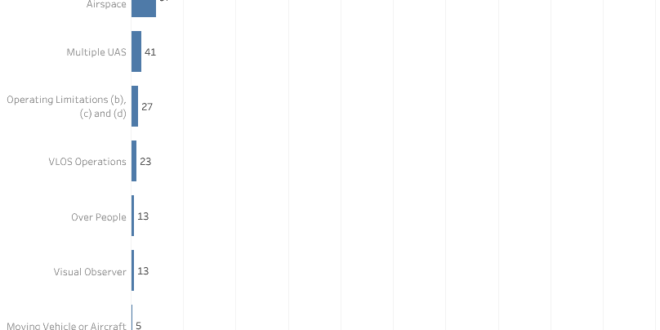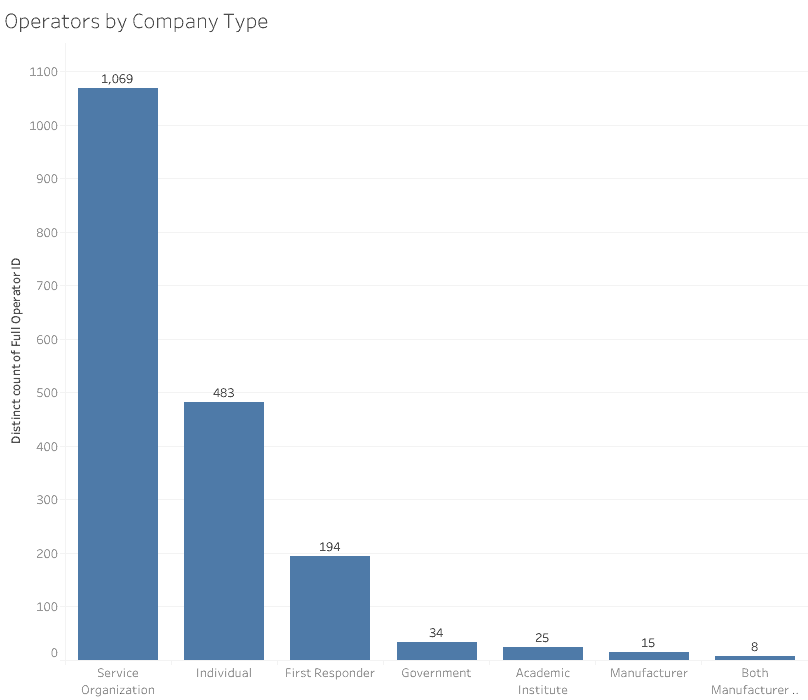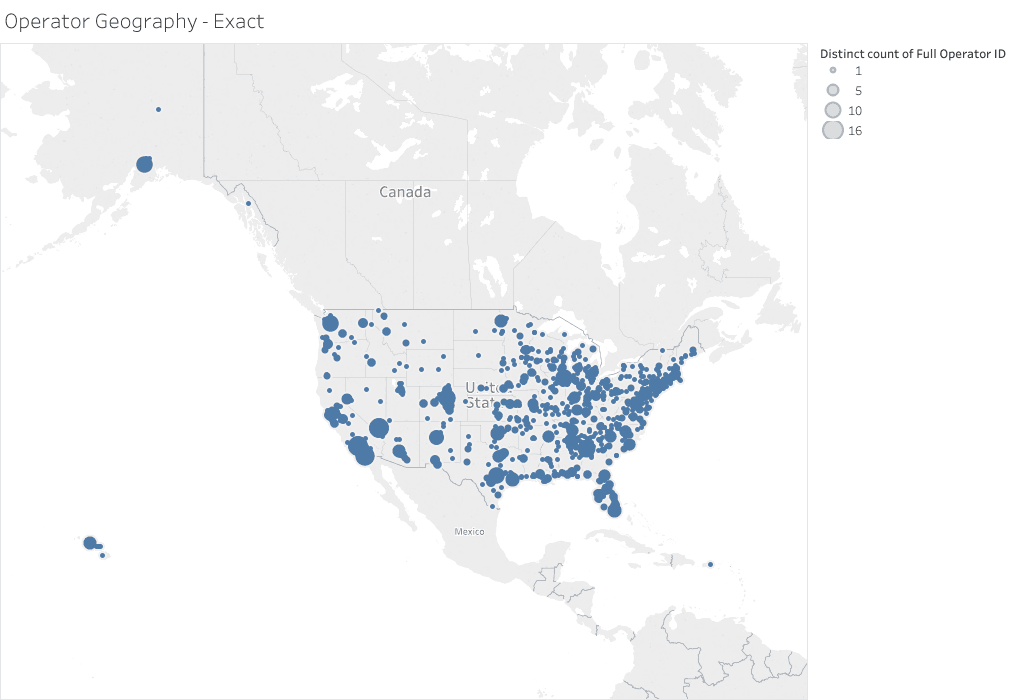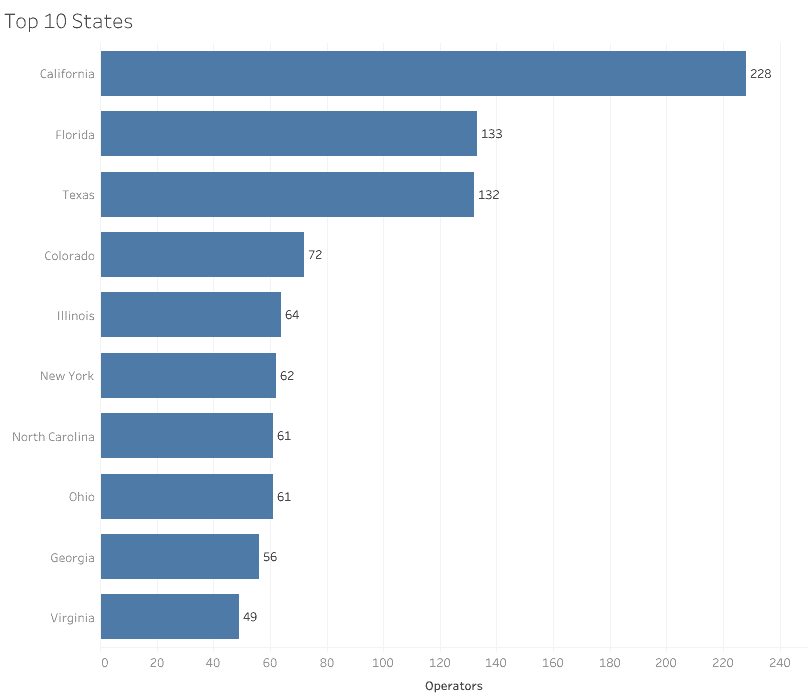It’s been about two years since the FAA implemented Part 107, also known as the small unmanned aircraft systems (UAS) rule, on August 29, 2016. Since then, the FAA has granted over 2,000 waivers to fly outside the requirements of Part 107, such as flying beyond the visual line of sight or at night.
AUVSI Study Reveals Surprising Trends Among Part 107 Waivers Granted
So who has applied for waivers successfully, and what were they for? The Association for Unmanned Vehicle Systems International (AUVSI) recently released an update to its analysis of waivers by the FAA, which includes findings on the most commonly requested waivers, types of operations authorized via waiver, and other unique findings.
Here are some key takeaways from the study:
- Operators in all 50 states and Puerto Rico have used waivers for expanded operations.
- The operators who received the most waivers reside in California, followed by Florida, Texas, Colorado, and Illinois.
- Flying at night is the most common reason operators request a waiver, with nearly 92 percent of the waivers granting permission to operate UAS at night.
- Small businesses are implementing UAS into their operations, with over 90 percent of the waivers granted to companies with annual revenues of less than $1 million.
- First responders are embracing expanded UAS operations, with close to 200 having received waivers.
Let’s take a closer look at some of the data collected by AUVSI.
What are the most common FAA Part 107 waivers?
The majority of waivers were for operations at night, accounting for 92% of the waivers granted with all other waiver types each accounting for less than 5%. Waivers were seldomly approved for flights over people, operations without a visual observer, and operations from a moving vehicle.
In their report, AUVSI analyzed 1,960 waiver documents granted to more than 1,800 operators in the past two years. The FAA has granted waivers to:
- Fly at night (1,800 waivers)
- Fly in certain airspace (97 waivers)
- Operate multiple UAS at the same time (41 waivers)
- Operate beyond other imposed operational limits of Part 107 such as speed, distance from clouds or flight visibility (28 waivers)
- Fly beyond visual line of sight (23 waivers)
- Conduct flights over people (13 waivers)
- Fly without a visual observer (13 waivers)
- Operate UAS from a moving vehicle (5 waivers)
Image Credit: Association for Unmanned Vehicle Systems International (AUVSI); Legend: Operating Limitations (b), (c) and (d) = 14 CFR §107.51 (b), (c) and (d) Operating limitations for small unmanned aircraft (altitude above ground level or relative to a structure (b); flight visibility (c); distance from clouds (d)) Operating Limitations (a) = 14 CFR § 107.51 (a) for small unmanned aircraft (specifically groundspeed)
BVLOS operations, flights over people, operations without a visual observer, and operations from a moving vehicle accounted for 1% or less of all waivers granted, but this does not mean pilots have not expressed interest in these types of operations. Rather, it’s more likely that waivers to fly over people have a lower approval rate than requests to fly potentially safer missions like flying at night.
Who is most likely to request a FAA Part 107 waiver?
Based on the study conducted by AUVSI, which captured a total of 1,828 unique operators, the operators who applied for waivers breakdown as follows:
- Over 58% are associated with some type of service-based organization
- 26% are registered as a responsible individual without an associated company
- 11% support emergency response organizations (such as fire or police departments)
- Less than 5% work for government agencies, academic institutes, or UAS manufacturers
This is demonstrated in the barchart below.
Where were the most FAA Part 107 waivers granted?
Using the FAA’s waivers granted database, AUVSI determined that the dispersion of waivers granted closely reflects the population density of the United States with large clusters in southern California, and in/around the cities of New York, Las Vegas, Atlanta, Chicago, Denver, Seattle, and Austin.
The top ten states for number of waivers granted were California, Florida, Texas, Colorado, Illinois, New York, North Carolina, Ohio, Georgia, and Virginia. This aligns closely with the distribution of Part 107 Certificate holders in the U.S.
If you’d like to view more charts like this, head on over the AUVSI full report. Go ahead—you can totally geek out with their interactive data sets and deep dive into specific cities, types of business, types of waivers, and other data filters.
How will the waiver process change in the future?
The FAA has been working to improve the waiver process with the issue of airspace authorization maps last year and the roll out of LAANC this year for immediate airspace authorizations. This summer, they also hosted a webinar series to increase drone operators’ understanding of the waiver process.
To apply for a Part 107 waiver, pilots use the FAA’s DroneZone Portal, and applications are granted on a case-by-case basis. The FAA requests up to 90 days to review and issue a decision, and they will approve the waiver if the applicant demonstrates they can fly safely under the waiver without endangering people or property on the ground or in the air.
The requirements to fly under 400 feet, within visual line of sight, and only during daylight hours are ultimately designed for safety, but they can be inconvenient and frustrating at times.
Commercial pilots trying to please clients with requests outside the parameters of Part 107 are hindered by the time it takes to request a waiver. For example, if a client requests footage of a night-time event such as a fireworks display or wedding reception, you won’t be able to commit to the job without first applying for a waiver to fly at night and/or over people. The FAA then requests up to 90 days to review and issue a decision, by which time the client may no longer need or want your services. In more serious scenarios, such as a search and rescue operation requiring BVLOS operations, the process may be expedited but still slow down the operation.
Members of the drone community have expressed a desire for a faster and more efficient waiver request process.
The continuing high demand for Part 107 waivers demonstrates that operators are more eager than ever to harness the great potential of unmanned aviation technology. In order for the industry to reach its full potential, we need to move beyond granting permission on a case-by-case basis, as we do today, and instead implement a regulatory framework that establishes rules for expanded operations. Until we do that, progress towards the goal of integrating UAS into the nation’s airspace will continue to stall.
—Brian Wynne, President and CEO, AUVSI
Implementing a regulatory framework for commercial operations and specific industries could further streamline, and potentially speed up, the waiver process for commercial drone pilots. We hope to see improvements in the waiver process as the U.S. Senate moves toward a decision on the FAA Reauthorization Bill. One topic on their agenda is to address ways to reduce the need for waivers and to foster innovation by authorizing expanded case-by-case exemptions for beyond visual-line-of sight, nighttime operations, and operations over people, as well as for research and development and commercial purposes. Improvements to the waiver process would open up the burgeoning sUAS industry to a multitude of new possibilities.
Share your own experiences with the FAA Part 107 waiver process, or tell us what changes/improvements you’d like to make to the waiver process in this thread on our community forum.
https://uavcoach.com/faa-waivers-granted/
 Unmanned Aerial Vehicle The latest drone news
Unmanned Aerial Vehicle The latest drone news







